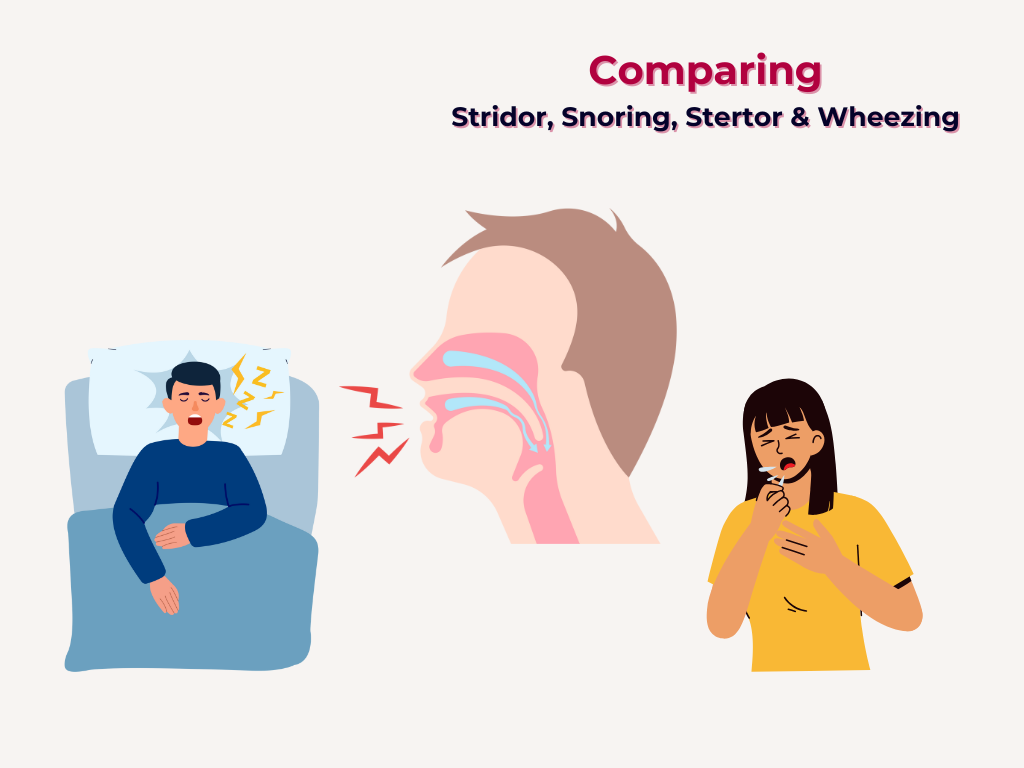The following are all types of noisy breathing;
-
Stridor:
A high-pitched sound heard during breathing, typically indicative of upper airway obstruction.
-
Snoring:
A low-pitched sound produced by vibration of the upper airway tissues during sleep.
-
Stertor:
A low-pitched snoring sound, often associated with nasal or pharyngeal obstruction.
-
Wheezing:
A high-pitched whistling sound heard during breathing, typically indicative of lower airway obstruction.
Epidemiology
-
Snoring:
Common in adults, especially those with obstructive sleep apnea (OSA).
-
Stertor:
Often seen in children with nasal or pharyngeal obstruction.
-
Stridor:
Can occur in anyone, but more common in children and individuals with upper airway obstruction.
-
Wheezing:
Common in individuals with asthma, chronic obstructive pulmonary disease (COPD), or other lower airway conditions.
Pathophysiology
-
Stertor:
Nasal or pharyngeal obstruction, often due to adenoid or tonsillar hypertrophy. Can occur during both wakefulness and sleep.
-
Snoring:
Vibration of upper airway tissues, often due to relaxation of muscles or anatomical obstruction. Typically occurs during sleep.
-
Stridor:
Upper airway obstruction, often due to foreign bodies, tumours, or anatomical abnormalities.
-
Wheezing:
Lower airway obstruction, often due to bronchospasm, inflammation, or mucus plugging.
Mechanism and Location
Snoring & Stertor:
Typically occur during inspiration, due to upper airway obstruction.
Wheezing:
Typically occurs during expiration, due to lower airway obstruction.
Stridor:
-
Inspiratory stridor:
Indicates obstruction above the vocal cords.
-
Expiratory stridor:
Indicates obstruction below the vocal cords.
-
Biphasic stridor:
Indicates obstruction at or near the vocal cords.
Here’s a breakdown of the location of obstruction for each type of stridor.
Inspiratory Stridor
Typically indicates an extrathoracic obstruction, often above the vocal cords.
Common causes include:
- Laryngomalacia
- Vocal cord paralysis
- Foreign body obstruction
- Tumors or cysts in the upper airway.
Expiratory Stridor
Typically indicates an intrathoracic obstruction, often below the vocal cords.
Common causes include:
- Tracheomalacia
- Bronchial tumors or foreign bodies
- Tracheal stenosis:
Biphasic Stridor
Typically indicates an obstruction at or near the glottis (vocal cords), which can be either extrathoracic or intrathoracic.
Common causes include:
- Vocal cord lesions or tumors
- Bilateral vocal cord paralysis
- Glottic stenosis
Summary of Key Differences
Between Snoring and Stridor
Snoring and Stridor are both abnormal sounds produced during breathing, but they have distinct differences.
Snoring
-
1. Low-pitched sound:
Typically a low-frequency sound.
-
2. During sleep:
Often occurs during sleep, especially in individuals with obstructive sleep apnea (OSA).
-
3. Upper airway obstruction:
Caused by partial obstruction of the upper airway, often due to relaxation of muscles or anatomical issues.
-
4. Common in adults:
More prevalent in adults, especially those with obesity, nasal congestion, or other risk factors.
Stridor
-
1. High-pitched sound:
Typically a high-frequency sound.
-
2. During breathing:
Can occur during inspiration, expiration, or both.
-
3. Upper airway obstruction:
Caused by significant obstruction of the upper airway, often due to anatomical abnormalities, foreign bodies, or other conditions.
-
4. Can occur at any age:
Affects individuals of all ages, including children and adults.
Key Differences
-
1. Pitch:
Snoring is typically low-pitched, while stridor is high-pitched.
-
2. Timing:
Snoring usually occurs during sleep, while stridor can occur at any time.
-
3. Severity:
Stridor often indicates a more significant obstruction or underlying condition.
Between Snoring and Stertor
Snoring and Stertor are both sounds produced during breathing, but they have distinct differences.
Snoring
-
1. Low-pitched sound:
Typically a low-frequency sound.
-
2. Upper airway obstruction:
Caused by partial obstruction of the upper airway, often due to relaxation of muscles or anatomical issues.
-
3. Often associated with sleep:
Commonly occurs during sleep, especially in individuals with obstructive sleep apnea (OSA).
Stertor
-
1. Low-pitched snoring sound:
Similar to snoring, but often more nasal or pharyngeal in origin.
-
2. Nasal or pharyngeal obstruction:
Caused by obstruction in the nose or pharynx, often due to adenoid or tonsillar hypertrophy.
-
3. Can occur during wakefulness or sleep:
Not limited to sleep, can occur during both wakefulness and sleep.
Key Differences
-
1. Location of obstruction:
Snoring can involve various upper airway structures, while stertor is more specifically related to nasal or pharyngeal obstruction.
-
2. Sound characteristics:
While both are low-pitched, stertor is often described as more nasal or guttural.
Understanding these differences can help identify the underlying cause of the sound and guide appropriate management. Also, for accurate diagnosis and treatment.
It’s essential to determine the underlying cause and location of the obstruction to guide appropriate management and treatment.
Investigations
-
1. Stridor:
Laryngoscopy, bronchoscopy, or imaging studies (e.g., X-rays, CT scans).
-
2. Snoring and stertor:
Sleep studies (e.g., polysomnography), nasal endoscopy.
-
3. Wheezing:
Spirometry, peak flow meters, or imaging studies (e.g., X-rays, CT scans)
Complications
-
1. Stridor:
Respiratory distress, airway compromise.
-
2. Snoring and stertor:
Sleep disturbances, daytime fatigue.
-
3. Wheezing:
Respiratory distress, exacerbation of underlying conditions (e.g., asthma).
Management
-
1. Stridor:
Depends on the underlying cause, may require airway management or surgical intervention.
-
2. Snoring and stertor:
Lifestyle modifications (e.g., weight loss, sleep position changes), CPAP therapy, or surgical intervention.
-
3. Wheezing:
Depends on the underlying cause, may require bronchodilators, corticosteroids, or other medications.
In conclusion,
Stridor, snoring, stertor, and wheezing are distinct respiratory sounds with different underlying causes and management strategies. Accurate diagnosis and treatment are essential to prevent complications and improve outcomes.
Share Post On:
Recent Posts
-
Nuggets of ORL-RHINOLOGY
-
Nuggets of Otorhinolaryngology-Basic sciences
-
Anatomy of the Muscles of the Soft Palate
-
Ethmoidal Arteries Ligation for Epistaxis
-
Submucous Cleft Palate (SMCP)
-
Approach to Ligation of the External Carotid Artery
-
Approach to Managing a 3-Year-Old Boy with a Foreign Body in the nasal cavity.
-
Approach to Managing a 3-Year-Old Boy with a Foreign Body impacted in the ear canal.
-
Endoscopic Sphenopalatine Artery Ligation (ESPAL) for Epistaxis
-
Surgical Management of Epistaxis
-
Technique of Incision and Drainage of Septal Hematoma/Septal Abscess
-
Upper Aerodigestive Tract Foreign Body Impaction
-
Incision and Drainage of Hematoma Auris
-
Rigid Bronchoscopy for Retrieval of Foreign Bodies in Children
-
Foreign Body Impaction in the Larynx, Trachea, and Bronchi
-
Leadership Position is a Tool, not a Trophy
-
Carcinoma of the Oropharynx
-
Peritonsillar Abscess
-
Ethics of Doctor-Patient Relationship
-
Doctor-Patient Relationship Case Scenarios
-
Asymmetrical Tonsils and Approach to Evaluation and Management
-
Nasal Polyposis
-
Rigid Oesophagoscopy and Complication
-
Anatomy of Oesophagus
-
Stridor, Snoring, Stertor And Wheezing: How They Compare
-
Temporomandibular Joint (TMJ)
-
Otoacoustic Emissions
-
Tympanometry
-
Functional Endoscopic Sinus Surgery (FESS)
-
Tracheostomy
-
Clinical Voice Test (CVT) for Hearing Loss
-
Acute Epiglottitis And Approach To Management
-
Synoptic Overview Of Nasopharyngeal Carcinoma
-
Prioritizing Support For People With Disabilities Over Unhealthy Competitions That Marginalise The Downtrodden
-
Otitic Barotrauma
-
Titbits of Informed Consent Process for a Medical or Surgical Procedure
-
Comprehensive Overview of Mpox (Monkeypox)
-
Overview Of Corrosive Ingestion - Acid & Alkalis, and Management Approach
-
Ethical Conundrum
-
Comprehensive Overview of Laryngeal Papillomatosis and HPV Virus
Categories
RELATED POSTS
Get in Touch
Read doctor-produced health and medical information written for you to make informed decisions about your health concerns.


